Humanity originated in Africa, and then spread around all continents. Today there are permanent settlements even in the harshest region on the Earth — Antarctica. The next step of our expansion is outer space. This dream is the central theme of many science fiction tales. We already know how to send manned vehicles to Earth orbits, and unmanned ones to neighboring planets and even beyond the solar system. However, there are currently only a few dozen of active astronauts, and the idea of creating human settlements outside our planet is still at the planning stage.

Manned space exploration looks really romantic in fiction, but in reality it is really dangerous for humans. A long stay outside the Earth is really full of challenges. So before you colonize other planets and star systems, you should practice living in such conditions. And the Moon is best suited for this being our closest celestial neighbor.
High radioactivity
It is obvious that building a lunar settlement will require considerable material resources and new technical solutions. Among the existing problems we should note the absence of an atmosphere on the Moon and, as a result, significant temperature drops and a high level of radiation. Terraforming is not a real option yet, so the future colony will consist of a complex of buildings either buried under ground or constructed on the surface. On Earth, life is protected from ionizing radiation by the atmosphere and magnetic field. The latter protects even the astronauts of the International Space Station, but every day they still get an amount of radiation equivalent to a year’s dose on Earth. On the surface of the Moon, the radiation level is even higher. If we do not find materials and technologies that will reduce the exposure to an acceptable level, the only option to maintain a vital activity of the colony will be the shift mode. Even if the inhabitants of our natural satellite will be protected inside buildings, they cannot avoid going outside time to time — to service solar panels, antennas, etc. or to visit neighboring colonies. No doubt, robots will be consistently taking over lots of maintenance functions, reducing the risk to people.
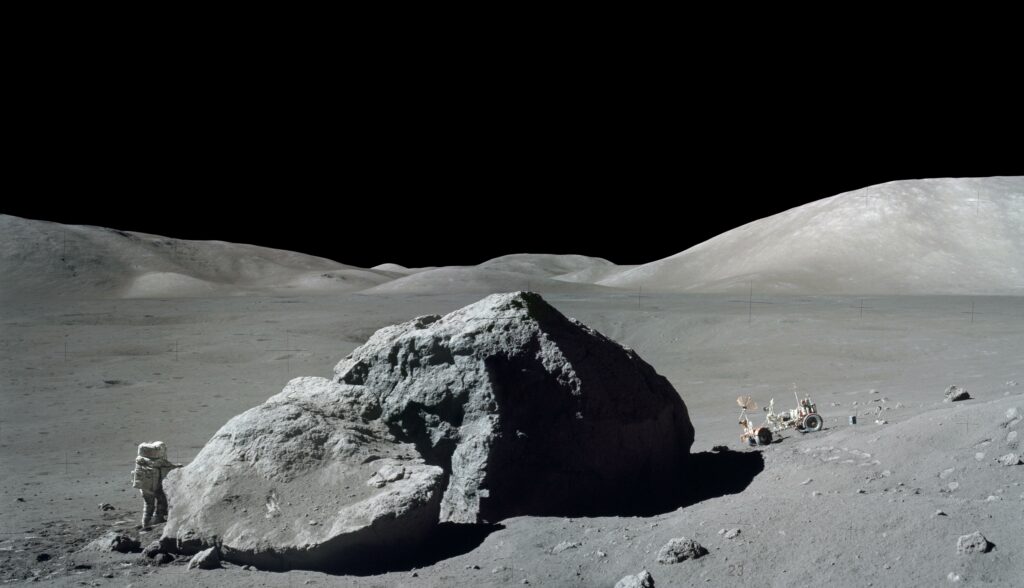
The researchers simulated the expected level of background radiation that would affect future astronauts during interplanetary travel, and studied its effects on the functioning of the brains of mice over a long period (6 months). The differences found were not very encouraging.
For instance, there was a decrease in neuronal excitability in the hippocampus, a brain structure responsible for learning and memory. In addition, there were changes in behavior that indicated dysfunction of the amygdala, one of the key structures that control emotions. Of course, people are not mice, but scientists suggest that in a radioactive environment, one in five astronauts or inhabitants of the lunar colony may get similar depressive disorders, and one in three — memory impairment.
Reduced gravity
Another obvious problem for future colonists is less gravity on the Moon. It is 16% of that on Earth. In such environment the muscles are constantly underloaded, and therefore they lose vitality — which is an absolutely normal physiological reaction. This process has already been observed while studying astronauts on orbital stations, but a long stay on the moon can have more serious consequences than short-term expeditions.
The solution to this problem can be physical training or therapeutic electrical stimulation of muscles. Scientists are also working on the creation of pharmacological agents capable of stimulating the musculoskeletal system under reduced gravity. One of the promising compounds with osteo- and muscle-protective effects is the natural substance resveratrol, which is found in the skin of grapes, blueberries and in red wine. Researchers from Harvard Medical School (USA) studied its effect on the muscle mass of rats living in simulated Martian gravity (twice that of the Moon). Of course, they could not change gravity; they only reduced the load on the muscles using special suspensions. The rats were in this state for two weeks. As expected, this manipulation led to a significant decrease in muscle mass and strength (andtotal body mass, accordingly). Taking resveratrol successfully compensated for such changes. So it is potentially effective in preventing muscular dystrophy during spaceflight and prolonged stays on low-gravity planets.
The next question is dosage. Researchers fed rats at the rate of 150 mg/kg/day. Red wine contains up to 5 mg/l of this substance, so an average person needs about 2,000 liters of wine to get the appropriate daily dose. Probably, the colonists will have to swallow pills, instead of relishing an alcoholic drink. Anyway, winemaking on the Moon will never be an easy task.
Growing plants on the moon
Let’s talk more about winemaking, or about growing plants in general. A lunar colony must be independent of food supplies from Earth; otherwise the project will not make sense. For stable and long-term functioning, it is necessary to build a closed ecosystem. One of its key elements is green plants able to produce biomass due to the energy of solar radiation. They will absorb carbon dioxide and produce oxygen for the colonists. The easiest option is to use edible microscopic algae such as chlorella or spirulina. However, such a monotonous diet is unlikely to provide an acceptable quality of life for people on the moon. So we will have to grow more diverse products.
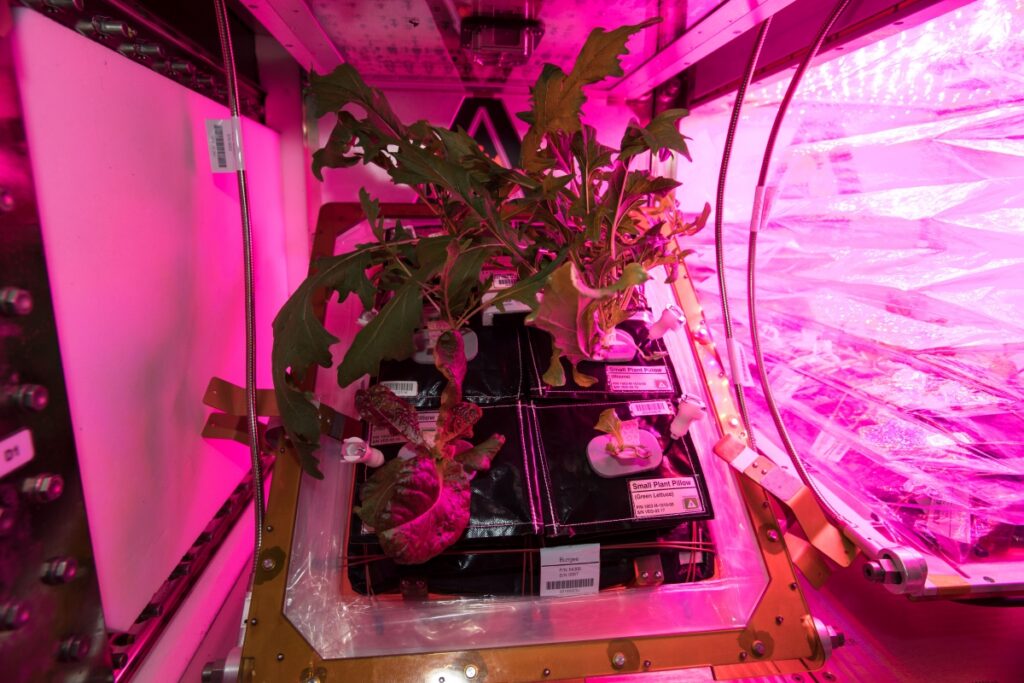
The “Veggie” (Vegetable Production System) project has been ongoing at the ISS since 2013. It is carried out by NASA specialists seeking to determine the nutritional validity of plants grown in space. For this purpose, edible lettuce Lactuca sativa was cultivated. The crop was harvested both gradually (picking ripe leaves every week) and once in a bulk. At the same time, control plants were grown on Earth, exposed to conditions similar to those in space (except for gravity, of course) with a delay of 24-72 hours. The microbiomes were compared (bacteria and fungi living on the lettuce) as well as the chemical composition of the crop. Some differences were found, but they were not about microbes dangerous to humans. They also found a certain difference in the number of Fe, K, Na, P, S and Zn atoms. However, in general, this did not reduce the nutritional value of space flora. It will be a little easier for plants on the Moon — because there is gravity there, albeit it is less than on Earth. For the successful functioning of the lunar garden, insects are also necessary, which can pollinate the plants, improve the soil for them, and, in addition, be food for humans. They multiply quickly; they are unexacting to living environment; and they are not inferior in nutritional value to “real” meat.
Creating a long-term self-regulating ecosystem
In general, the creation of a long-term self-regulating sustainable artificial ecosystem is a complex scientific task. One of the attempts to solve it is the Biosphere 2 project, launched in 1985. This is a hermetic isolated structure, erected in the state of Arizona (USA). Samples of terrestrial flora and fauna were collected there. The system had to be isolated from the entry of foreign organisms, chemicals and energy sources, with the exception of sunlight. The initial team consisted of eight volunteers. Their goal was to survive there for two years — similar to what we would expect from a lunar colony. However, the first attempt turned out to be unsuccessful — the ecosystem became unbalanced, oxygen consuming bacteria multiplied (so the oxygen had to be added from the outside), the yield of plants was less than calculated, some species (in particular, pollinating insects) died. The volunteers managed to complete the experiment, but its result was not as expected.
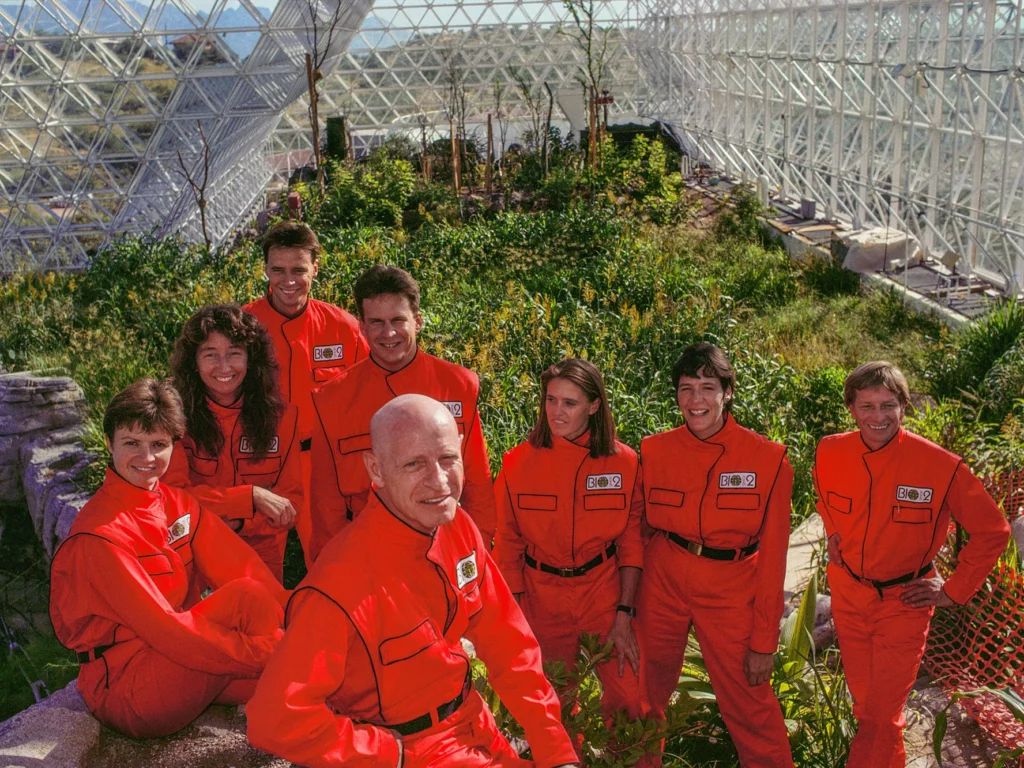
Biosphere 2 is not the last such project. Currently, the MELiSSA (MicroEcological Life Support System Alternative) mission is underway under the leadership of the European Space Agency (ESA) together with almost 30 different organizations. Its goal is to develop a closed system of human life support — something that will be needed for survival of colonists on the Moon or on Mars.
Psychological factor
The closed space of a colony provokes psychological unbalancing. Of course, the first colonists will be carefully selected for ability to cope with limited space and a small group of people. A considerable arsenal of selection tests and methods of conflict resolution has been accumulated — they were tested during the formation of teams of sea expeditions or winterers on research stations in Antarctica. However, in the case of a long-term expedition, more complex issues will arise — the formation of married couples, the upbringing of children, etc. Here, on Earth divorced people can just go to different streets or even to different cities. In the limited space of the colony this will be impossible. Probably, the stability of the society of the colonists will require the development of new social models, and this is a job for sociologists.
Allergy to lunar dust
Let’s go back to biology. Of course, exploration of the Moon will bring many surprises to mankind, not always pleasant ones. Science currently has no more than results of available observations on the ISS, where one astronaut doesn’t spend more than a year continuously at the station. But a lot of other data has been accumulated. Moon dust is known to be a problem. Due to the absence of winds, its particles do not rub against each other and keep their sharp edges. Even more, they acquire an electric charge, which helps them to penetrate everywhere. To get rid of dust inside the colony, it will be necessary to use special filters. Outside, it will create problems for moving mechanisms (antennas, solar panels, etc.). The study of the properties of lunar dust is problematic, because in the Earth conditions, it behaves completely differently.
It turns out that you can be allergic to the moon, like to the pollen of earthly flowers. Apollo astronauts reported similar symptoms. At the same time, they were on the surface of the Earth’s satellite for a very limited time. What will happen when humanity builds a permanent base there?
The study of physiological changes in the human body as a result of being in space is an interesting task, but it is beyond the scope of this article. In addition to the changes in the musculoskeletal system mentioned above, there is information about blood coagulation, and some issues with immunity, circulation and, of course, the nervous system.
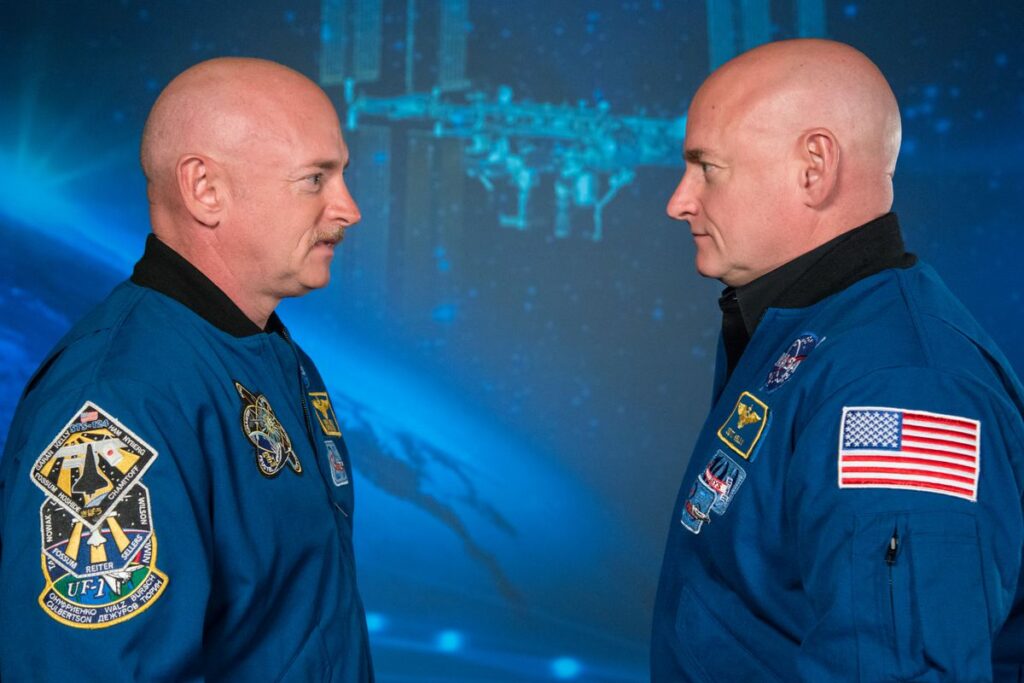
The results of a unique NASA experiment were recently published. Specialists monitored the health of astronaut Scott Kelly during his stay on the ISS. At the same time, the condition of his twin brother Mark Kelly, who was on Earth, was also monitored. One of the discovered facts was the decreasing the lengths of telomeres in Scott’s organism. The telomeres are the end sections of chromosomes that protect them from damage. Normally, a decrease in telomere length is associated with the aging process. Probably, in orbit, this effect is caused by the increased radiation background. Scientists have collected a lot of other data. In particular, Scott Kelly was vaccinated (from the flu) for the first time in the history of space exploration. It is notable that the body’s immune function has not changed. Details of the results of the NASA’s Twins Study project can be found on its official website.
Sleeping on the moon
The issue of sleep on the moon is also interesting, since the lighting cycle there is significantly different from that on Earth. Of course, it can be corrected artificially, but the factor of reduced gravity remains. The flight of the first cosmonaut, Yuri Gagarin, was too short. Herman Titov became the first person to sleep in space, and the first long-term sleep recording was made by the Americans in 1965. To simulate the daily rhythm, the portholes of the ship were even curtained to “cancel” the cycle of 90-120 minutes associated with orbiting around the Earth. However, the conditions of the spacecraft were unsuited for adequate rest due to the lack of space and the uncomfortable positions of the astronauts. Sleep was studied in more detail during the Skylab program (1973-74). It turned out that the total duration of sleep in space is shorter than on Earth, but the results of observations were influenced by the work schedule, social and other factors. Observing the long-term stay of cosmonauts at the Mir station revealed that with adaptation, the duration and structure of sleep also normalizes. So, future colonists probably don’t have to worry about this aspect, which is nice considering the scope of the problems mentioned above.
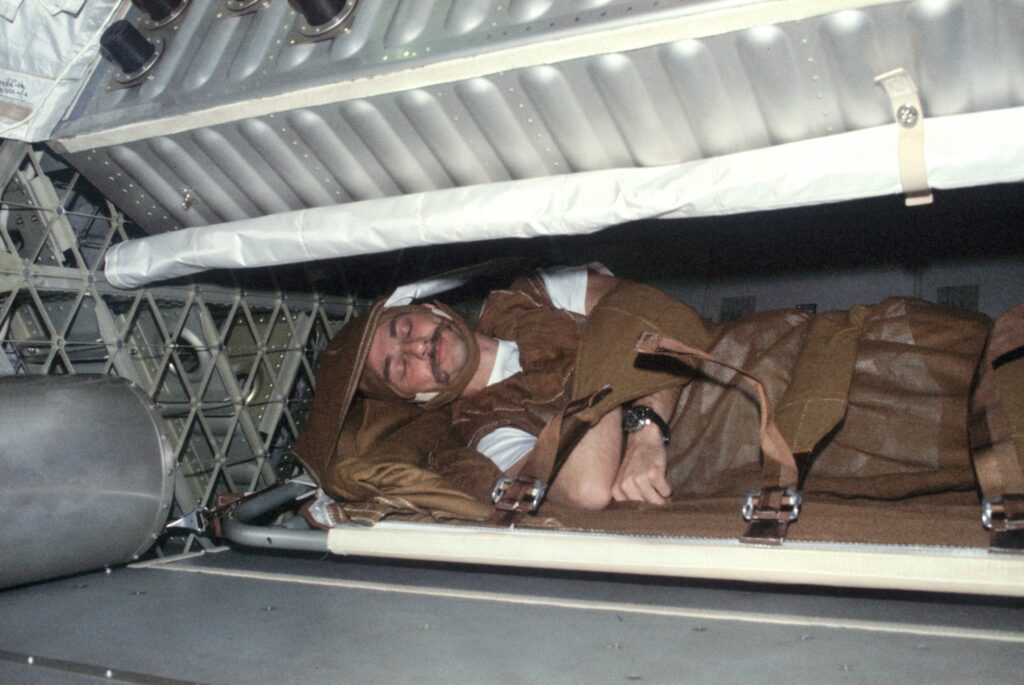
The author of this text had a privilege to take part in one of the scientific “space projects” led by ESA. Its goal was to determine how microgravity affects the hippocampus, the brain’s memory and spatial orientation center. The experiment was carried out on an airplane that performed so-called parabolic maneuvers: it flies up with a double acceleration, then its engines are turned off for a while, and the airplane begins to “fall.” Of course, no one allows it to crash — in 20 seconds the engines are turned on again, but during this period of free fall there is a state of “weightlessness”, or rather, microgravity. This cycle was repeated 31 times. The subjects were mice with electrodes implanted in their brains, recording the activity of their hippocampi. It turned out that the onset of “weightlessness” was accompanied by the disappearance of a specific rhythm in this activity, which renewed after the restoration of gravity. Therefore, changes in this rhythm can be considered as a correlate of the brain’s response to changes in gravity. It turned out that short-term adaptation to changes in gravity is difficult in animals with a damaged hippocampus. The degree of development of this brain structure is different among humans — for example, it is quite high in London professional taxi drivers, which helps them not to “get lost” in the city. Perhaps brain scans and hippocampal volume measurement will become one of the career orientation tests for future space vehicle pilots, so that they navigate flawlessly in space during rapid changes in acceleration.
So, currently, building a base on the Moon is associated with a considerable number of challenges. We are not able to manage all of them yet. But never doubt: humanity knows where to move and it will cope!

